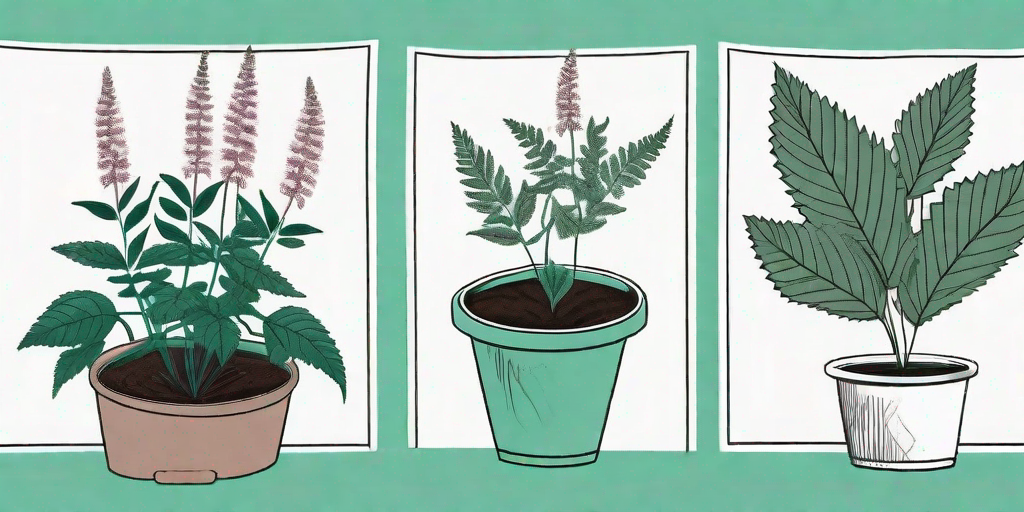
Welcome to the world of Astilbe, where the flowers are fluffy, the leaves are fern-like, and the gardening is...well, a bit tricky. But fear not, fellow green thumbs! This guide will walk you through the process of transplanting Astilbe, from root to bloom. So, put on your gardening gloves, grab your trowel, and let's get digging!
Understanding the Astilbe Plant
Before we dive into the nitty-gritty of transplanting, let's take a moment to appreciate the Astilbe in all its glory. Native to East Asia, this perennial plant is known for its feathery plumes and attractive foliage. It's a shade-loving plant, which makes it a popular choice for those tricky parts of the garden where the sun doesn't quite reach.
There are many varieties of Astilbe, each with its own unique characteristics. From the dwarf Astilbe 'Pumila' to the towering 'Purple Candles', there's an Astilbe for every garden. But no matter which variety you choose, they all share one thing in common: they need a little TLC to thrive.
Characteristics of Astilbe
Astilbe plants are known for their feathery, plume-like flowers that come in a variety of colors, including white, pink, red, and purple. These flowers bloom in the summer and can last for several weeks. The leaves of the Astilbe plant are equally attractive, with a fern-like appearance and a deep green color.
One of the unique characteristics of Astilbe is its love for shade. While most flowering plants require plenty of sunlight, Astilbe prefers the cooler, shadier parts of the garden. This makes it an excellent choice for those difficult-to-plant areas under trees or alongside buildings.
Transplanting Astilbe: A Step-by-Step Guide
Now that we've gotten to know Astilbe a little better, it's time to get our hands dirty. Transplanting Astilbe might seem daunting, but with a little patience and the right technique, you'll have a thriving Astilbe garden in no time.
So, without further ado, here's your step-by-step guide to transplanting Astilbe:
- Choose the right time: The best time to transplant Astilbe is in the early spring or fall when the plant is dormant. This reduces the stress on the plant and increases the chances of successful transplantation.
- Prepare the new location: Astilbe prefers well-drained, slightly acidic soil. Amend the soil with compost or peat moss to improve its fertility and drainage.
- Remove the Astilbe from its current location: Dig around the base of the plant, taking care not to damage the roots. Gently lift the plant from the ground.
- Transplant the Astilbe: Place the Astilbe in the prepared hole, making sure the top of the root ball is level with the soil surface. Backfill the hole with soil, firming it gently around the base of the plant.
- Water thoroughly: After transplanting, water the Astilbe thoroughly. Continue to water regularly, especially during dry periods.
Post-Transplant Care
Transplanting is just the first step in your Astilbe care journey. After transplanting, it's important to provide your Astilbe with the right care to ensure it thrives in its new location.
Here are some tips for post-transplant Astilbe care:
- Water regularly: Astilbe prefers moist soil, so regular watering is essential. However, be careful not to overwater, as this can lead to root rot.
- Mulch: Applying a layer of mulch around the base of the Astilbe can help retain moisture and suppress weeds.
- Fertilize: Apply a balanced fertilizer in the spring to promote healthy growth and abundant blooms.
- Prune: After the flowers have faded, prune back the stems to promote new growth.
Frequently Asked Questions
When is the best time to transplant Astilbe?
The best time to transplant Astilbe is in the early spring or fall when the plant is dormant.
How often should I water my transplanted Astilbe?
Astilbe prefers moist soil, so regular watering is essential. However, be sure not to overwater, as this can lead to root rot.
How do I prepare the soil for Astilbe?
Astilbe prefers well-drained, slightly acidic soil. You can improve the soil's fertility and drainage by amending it with compost or peat moss.
And there you have it! With this guide, you're well on your way to becoming an Astilbe transplanting pro. So go ahead, roll up your sleeves, and let your Astilbe garden thrive from root to bloom!















